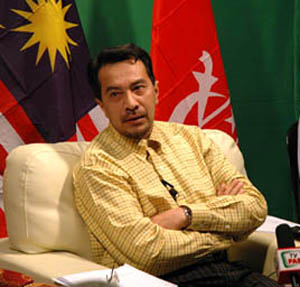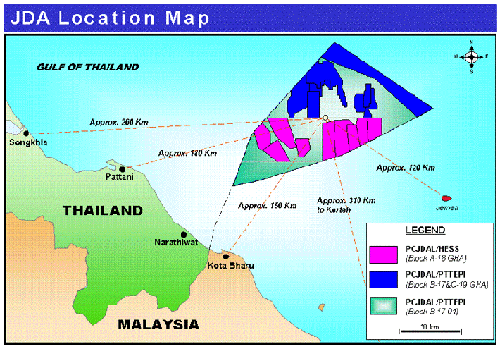By Danny Lim
dannylim@malaysiavotes.com
KOTA BHARU: PAS vice-president Datuk Husam Musa has claimed that Barisan Nasional’s (BN) own assessment of voter sentiments in Kelantan revealed that PAS has the edge in at least 26 out of 45 state seats and 10 out of 14 parliamentary seats. However, the Kota Bharu Umno division chief secretary Zulkifli Mustafa questioned the reliability of the information and said the BN would win in Kelantan.
Husam’s claim was based on information purportedly acquired from the BN operations centre in Kelantan. In a press conference on March 5, just before noon in Kota Bharu and which was streamed live on the Internet, Husam reeled off the number of seats that the BN had allegedly categorised as black (PAS strongholds “impenetrable” to the BN), black-grey (PAS leading by some distance), and grey (PAS marginally ahead), based on the BN’s reading on the ground.
 For state seats, seven were black, six were black-grey and 13 were grey. For parliamentary seats, two were black, another two were black-grey and six were grey.
For state seats, seven were black, six were black-grey and 13 were grey. For parliamentary seats, two were black, another two were black-grey and six were grey.
He would not reveal where any of these seats were located. If this information proves to be accurate, which Husam claimed to be the BN’s assessment as of Wednesday night (March 5), that would put PAS in control of the state.
When MalaysiaVotes.com later tried to verify Husam’s claims with the Kota Bharu Umno division, its chief secretary Zulkifli wondered how Husam could have acquired that information. Zulkifli implied that false information could’ve been ‘fed’ to Husam. “There is accurate information, and there is information for propaganda,” said Zulkifli. “This is just psychological warfare. We are very confident that the Barisan Nasional will win this election. We can see it from the strong response of the voters to our campaign.”
At the press conference, Husam also pushed the issue of the natural gas reserves off the shores of Kelantan. A circular distributed to the press at the PAS operations centre before Husam arrived was titled “Kenapa BN teringin sangat untuk rampas Kelantan (Why the BN badly wants to take over Kelantan)”. It provides details of 13 trillion cubic feet of natural gas reserves in Kelantan waters that are ready to be exploited, listed as Block A 18, B17, C19, PM3, Sub-Block Ular, PM301, PM302, PM303, PM311 and PM312.
PAS claims that operations on these gas fields should directly and indirectly benefit the state in royalties, and auxiliary support developments like onshore receiving facilities and supply bases. PAS claims that the BN government has concealed this information from the Kelantanese and selected onshore receiving facilities, for instance, for the gas field Block A 18, to be based in Songkhla, Thailand even though it is further, and thus costlier, than Kota Bharu.
By the party’s own calculations, Block A 18 currently produces 6,000 barrels of natural gas. PAS claims that Petronas should pay Kelantan RM512,000 per day in royalties, amounting to RM186 million a year. Through this revenue, PAS promises to subsidise cooking gas by RM3 per barrel for the state, as well as fund welfare and poverty eradication programmes.
“[Another gas field], PM301, is within Kelantan waters, just off the coast of Bachok and Pengkalan Chepa,” said Husam. “At least six wells have been confirmed to be suitable for production. According to Petronas’ schedule, we predict we will get royalties starting from 2009.”
Husam said the Marine Department had already agreed with the state government on the rights for onshore receiving facilities, and that the state government would initially invest RM100 million to develop the facilities and build five open petroleum storage tanks.
“The distance from the Kemaman supply base in Terengganu [to the aforementioned gas fields] is about 230km,” said Husam. “The distance from Songkhla is about 230km to 260km. The nearest point is Kota Bharu, which is about 180km. So economically, operators prefer to save costs because this activity is on a long-term basis. So we strategically try to locate ourselves in this development.”
According to a past Business Times report, Block PM301 is operated by CS Mutiara Petroleum Sdn Bhd, a joint venture between Petronas Carigali Sdn Bhd and Shell Exploration and Production Malaysia BV. Drilling operations commenced in February 2005. Block A 18 is operated by Carigali Hess, a joint venture between Petronas Carigali and Amerada Hess Corporation.
Some of the gas fields mentioned, like Block A 18, lie in the Joint Development Area (JDA), an area in the lower part of the Gulf of Thailand claimed by both Malaysia and Thailand. In 1979, the Malaysian and Thai governments agreed to jointly explore the non-living natural resources of the JDA. As of 1990, the JDA has been supervised and administered by the Malaysia-Thailand Joint Authority. The JDA’s gas reserves are estimated to last for between 14 and 22 years.
In February 2000, the two governments jointly embarked on the Trans Thailand Malaysia gas pipeline and separation project, where natural gas from the JDA were to be transported to Thailand and processed there. The US$2.42 billion, 255km pipeline will link to the Malaysian Peninsular Gas Utilization pipeline in Changlun, Kedah.
Other sources:
http://www.hydrocarbons-technology.com/projects/thaimalaysia/index.html#thaimalaysia1
http://www.mtja.org/main.htm
http://phx.corporate-ir.net/phoenix.zhtml?c=101801&p=irol-newsArticle&ID=657428&highlight=
http://www.hydrocarbons-technology.com/projects/thaimalaysia/index.html#thaimalaysia1
